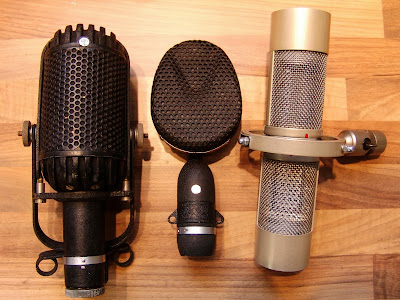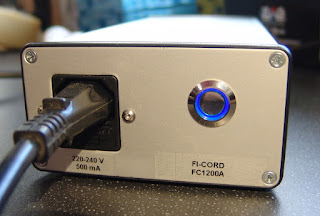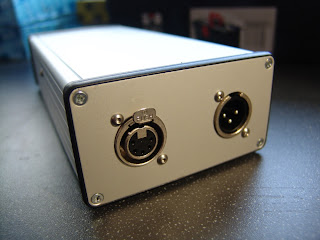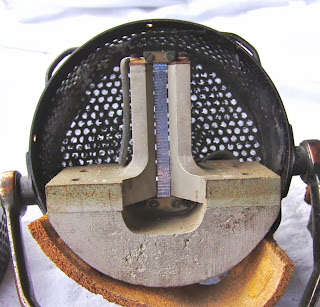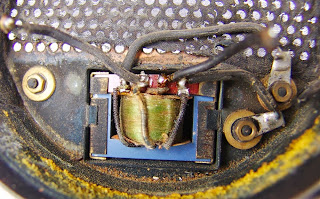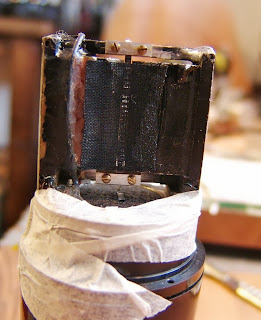 |
| Film industries ribbon mics |
When describing ribbon mics on this blog, I often note the output impedance of the mic, and possibly the transformer ratio too. Occasionally I receive messages asking how the impedance relates to output level, so here I will try to outline the role that the transformer plays in a ribbon mic. A ribbon mics is a very simple device, and if we consider how it works we will see just how important the transformer is.
In the beginning.... Let there be mics!
If we place a thin, light strip of corrugated aluminium* foil in a magnetic field, it will move in response to sound waves, and, just like an alternator, will induce an electrical potential that oscillates with changing velocity. We have a ribbon microphone!
 |
| Tannoy mic - ribbon, magnets and transformer |
But to get a useful signal out of the ribbon, we must complete the circuit and connect it to something. Because the voltage of the signal is too low to connect directly to a mic preamp, a transformer is used to increase the output to a more usable level**. So far so good, but what kind of transformer do we need? That depends on the destination of the signal and how far it has to travel to get there.
The Good Old Days
In the early days of sound recording with ribbon mics, the destination would usually have been a tape recorder of some kind, with a tube preamplifier to receive and boost the signal from the microphone.
In the early days of sound recording with ribbon mics, the destination would usually have been a tape recorder of some kind, with a tube preamplifier to receive and boost the signal from the microphone.
The mic could be connected in two ways: the budget option would be a high impedance connection using an unbalanced screened cable through a capacitor and straight to the tube grid, just like a guitar! The drawback is that unbalanced, high impedance connections are prone to picking up noise, and parasitic capacitance will limit the length of cable that can be used before the higher frequencies become significantly attenuated.
A better approach is to use a balanced cable to a second transformer in the preamp. The balanced connection will give better rejection of noise and long cable runs can be used. With 30 to 50 ohm microphones it is possible to run cables for hundreds of meters, which was ideal for broadcast and film recording. For these reasons the early impedance standards for microphones in the UK were 30 to 50 ohms for professional use, and high impedance for consumers. Broadcasters in other countries had different standards which just compounds the confusion - for example many Japanese microphones are 600 ohms.
The impedance can be set using the output transformer: Let us make an imaginary ribbon microphone for some thought experiments! In our imaginary microphone, the ribbon in the magnetic field might produce a signal of 1 mV for a given sound level, and the aluminium itself might have an impedance of 0.2 ohms. But the transformer primary winding also has some resistance, and that would add another, say, 0.1 ohms to the impedance of the primary circuit to give a total of 0.3 ohms.
 |
| Film Industries transformer dissected |
So we will make the transformer with a 1:10 ratio. This increases the impedance by a factor of the ratio squared, so in this case we need to multiply our 0.3 ohms from the primary circuit by 100, which gives 30 ohms. The secondary winding also has resistance, which might be of the order of 2 ohms, and we need to add that in. So overall we have a 32 ohm impedance for our microphone, which is suitable for older 30/50 ohm equipment.
What about the output level? The 1mV signal is multplied by the transformer ratio, so we now have 10 mV output, which equates to a 20dB increase in signal.
This Is The Modern World
Over the decades, broadcast and recording equipment has become more standardised, and most modern mixing desks and dedicated mic preamps are made to work well with microphones of up to around 600 ohms.
Ribbon microphones tend to have low outputs compared to modern dynamic and condenser mics, so it is advantageous to squeeze out as much level as we can. So, let's go back to the transformer in our imaginary ribbon mic and re-design it for use in the today's recording environment. We can keep the same primary winding, but change the secondary winding to one with a higher turns ratio.
 |
| Xaudia ribbon mic transformers being assembled |
Let's make it a 1:32 transformer, so now we need to take our 0.3 ohms from the ribbon and primary winding and multiply it by 32 squared, which gives 307 ohms. Once again we need to add the resistance from the secondary winding - in this case the wire is not only longer from the extra number of turns, and also will be thinner because we have squeezed the extra turns into the same space. A typical value would be 20 ohms, which would give us 327 ohms altogether, which most modern preamps can cope with quite happily.
Our output level will now be 32 mV, or 30dB gain with respect to 1 mV. So we have an improvement of +10dB over the 32 ohm transformer.
No Free Lunch
In life, and in physics, we know that you don't get something for nothing. So are there any drawbacks with increasing the ratio. The higher impedance can increase the resistance noise, so it is important to make sure that the transformer is well designed with a very low DC resistance, particularly for the primary winding. However, the extra 10dB could be the difference between asking 50 dB gain from the preamp, or cranking it up 60 dB gain, where many preamps are becoming noisy.
Ancient and Modern
In most cases, it is worth getting the transformer right and demanding a bit less from the preamp. With vintage ribbon microphones it is very often possible to re-wind the original transformer to a higher ratio to get more output from the microphone. If the original laminations and winding style is used, the vintage tone of the mic can be retained, and overall this can give a stronger signal and a better signal-to-noise ratio into modern equipment.
 |
| Vintage Ferrograph and Wearite matching transformers |
Another option is to use an impedance matching transformer. Back in the 1950s and 60s, most manufacturers of ribbon mics sold transformers to solve all kinds of matching problems. One example is this line matching transformer from Reslo, which connects a low impedance mic to a high impedance tape recorder. Xaudia make impedance matching transformer boxes with XLR fittings to do exactly the same job in a modern studio.
In part 2 of these ramblings I will discuss the effects of the transformer's inductance and resistance characteristics.
*Usually corrugated, and usually aluminium!
** Almost always. I have seen one example of a transformerless ribbon mic, but it is a crazy design!


